The music is an amazing human expression! It is a great company, inspiration, relaxation, catharsis, and a great way of traveling. Through songs, their lyrics, rhythm, instruments they are played with, we can know a bit more about people around the world. Their roots, what makes them sad, happy, angry, worried, etc. Music makes us sing, jump and shake the body but it also encodes a lot of cultural elements that are worthy to know.
Let’s explore together the case of the popular Mexican mariachi!
| Follow PackAndGo.info at: | |
| YouTube | @packandgo. |
| @packandgo.info | |
| X | @packandgoinfo |
| Bluesky | @packandgo.bsky.social |
| @packandgo.info | |
| TikTok | @packandgo.info |
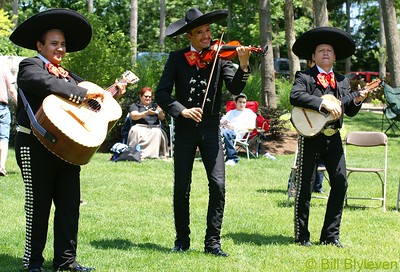
What’s mariachi?
The mariachi is the iconic musical ensemble of Mexico that incorporates mostly stringed, but also wind instruments to play and vocals. Mariachi is an indigenous Mexican word attributed to the already extinct Coca language. Coca people were an old indigenous group that settled in the region of the current states of Nayarit, Jalisco, and Colima.
Traditionally, these ensembles feature at least three musicians (guitar, guitarrón, and vihuela performers) dressed in “charro” suits. There’s no limit up to integrating a mariachi. Currently, there are musical groups of more than ten members. The mariachi is an important element of the Mexican tradition and identity. The word mariachi is also used to point out every member of the musical ensemble. The performers are mariachis and the group they integrate is a mariachi.
These kinds of ensembles boosted the popularity of the musical genre called “ranchero”. It’s an iconic Mexican genre considered in a wider category called “regional Mexican music”.

What’s the origin of mariachi? Is mariachi Mexican?
Yes, the mariachi is Mexican! It was born as a result of a mixture of different influences, the indigenous Mexican, the African, and the European ones. Africans arrived in Mexico together with the Europeans (16th century).
By the time the Spanish arrived in Mexico (1519), the Mexican indigenous had already developed their own musical instruments and traditions. European musicians brought to the new land their own music, just like the African slaves. With time, Mexican indigenous got interested in the foreign instruments and rhythms so they mastered them and incorporate them into their own music.
The mariachi grew up in a big Mexican region that included the current states of Sinaloa, Durango, Colima, Michoacán, Aguascalientes, Guanajuato, Zacatecas, Jalisco, Nayarit and Guerrero. Commonly, Jalisco is mentioned as the place of its origin. Truth is, there’s no certainty about the exact mariachi birthplace. Its presence has been traced all around this region.
The fusion of the indigenous teponaztlis, reed flutes, caracolas, and other native instruments, with the foreign guitars and violins, originated the earliest version of mariachi (17th. century).
A documented reference shows that mariachi is mentioned by the priest Cosme Santa Anna in a letter (1852). The musical ensemble is described as an element of the rural parties. Frequently, people were dancing on a wooden platform called “tarima” while mariachi was playing “jarabes” and “sones”. These last are common musical genres played by mariachi.
At this stage, the performers (mariachis) didn’t wear the current “charro” style clothing. They were mostly wearing peasant garb and palm hats, regional clothing related to rural activities.
The Mexican Revolution was a hard war decade for Mexicans (1910-1920). And exactly at that time, the mariachi got really popular and became a pride symbol, present in all types of events of poor, middle, and high classes.
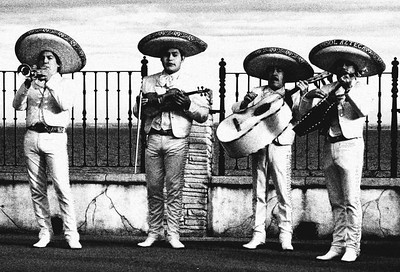
At the beginning of the 20th. century, the “charro” suit replaced the peasant garb that mariachi performers used to wear. The “charro” suit was the kind of clothing used by cowboys and horse riders. Depending on which hacienda the rider came from, suits varied in colors, shapes, and the material used to tailor them. Richer men wore suits made of wool, suede, trimmed with silver, etc. There were also humbler versions of suits. The palm hat also was changed for a wide brim hat. The first ensemble that adopted this suit as a uniform was “The Cirilo Marmolejo’s Mariachi”. And in 1930, trumpets were included by the same musical group to innovate the sound.
The radio and television positioned mariachi nationally. But the following years marked the beginning of one of the best moments of the Mexican film industry. And mariachis were a constant and successful element in many movies (“rancheras”). The Golden Age of Mexican cinema (1936-1956) totally boosted mariachi to the international level as an icon of the Mexican culture.
What instruments are used in a mariachi?
Instruments and the amount of them can vary between the different groups, mostly based on regional tendencies. But in general, the instruments that are used in a mariachi are the following.
- Mexican vihuela.
Mexican vihuela is a small, guitar-like instrument. It basically has five strings and a convex (vaulted) back. This instrument is tuned an octave higher than a guitar is. Therefore, vihuela gets a higher pitch or tenor sound. This instrument is one of the bases of the mariachi’s sound. It complements the low tuning of the guitar.
There’s a Spanish vihuela but don’t be confused, they are not the same instrument. Their different features give as a result different possibilities and sounds.
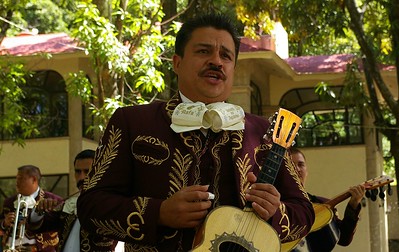
- Mexican guitarrón.
Guitarrón is a large, plucked instrument with six strings, a deep body, and acoustic bass. Another key instrument for a mariachi. Its size provides volume enough not to depend on electric amplification. Of course, the need for amplification will be finally defined by the venue’s size. Its higher three strings are usually made of nylon, while the lower three are made of metal. The Mexican guitarrón produces a powerful sound every time you pull a string. Its convex back and the hollow and large body improve lower frequencies. As a result, a rich bass sound is produced and it becomes the backbone sound line of mariachi, together with the Mexican vihuela and the guitar.
The Mexican guitarrón is a vital and colorful instrument for mariachi. Both, its size and warm sound can’t be unnoticed.
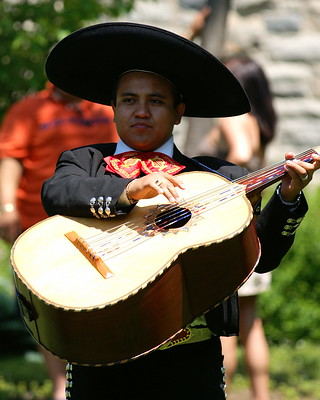
- Guitar.
Originally, mariachis included the Mexican “guitarra de golpe”. It was a guitar especially developed by Mexican mariachis-musicians. But with time, it has been replaced in many groups (not all) by the classical Spanish guitar.
Basically, guitarra de golpe has 5 nylon strings, a slimmer neck, and a design for the instrument not to buzz when the rhythm is played.

- Violin.
The violin adds to the mariachi a powerful tone and strong vibrato; a clear anchor for the mariachi’s sound. The violin or violins are used to get “grace notes” (ornaments), pizzicato, and interesting countermelodies with the trumpets. This means violins can produce rhythmic and melodic contrasts with the main melody or with the trumpets’ part.
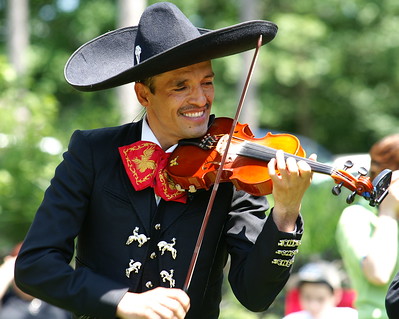
- Trumpet.
The trumpet is the latest and a “flashy” addition to mariachi but now it’s considered an essential. The instrument adds a thick, wide sound, and what is called in music, a “crisp sound”. Meaning, a bright sound that can even overtake the melody. Trumpet solos in mariachi are not rare and people like them. The high-pitched and bracing trumpet’s tone is a must for the classic fanfare that points out loud the presence of mariachi. It’s also an accent to emphasize the “celebration” mood.

- Vocals.
Singers are another important element. The vast repertoire of mariachi also includes instrumental music and instrumental versions of popular songs. But vocals are traditionally used. The difference with other musical groups is that in mariachi is not a must to have a lead singer. There can be more than a single singer and in fact, all the members of the ensemble frequently sing harmonically all together or specific verses of the songs.
The lead singer or singers are chosen based on their specific voice’s qualities and the needs songs (genres) demand.
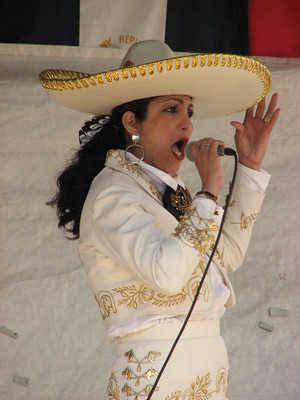
- Harp.
The most popular harp used by mariachi is the Jalisco harp. But it’s a preference, not a rule. It can have up to thirty-six strings. The shorter strings (length) provide a higher pitch (soprano, tenor). While the longer strings provide a lower (bass) pitch. Sometimes the harp is skipped because it’s hard to tune and transport.
The harp can be used by the mariachi with different objectives. It can play the bass line together with the guitarrón. It can play a melody line, chords, and arpeggios.
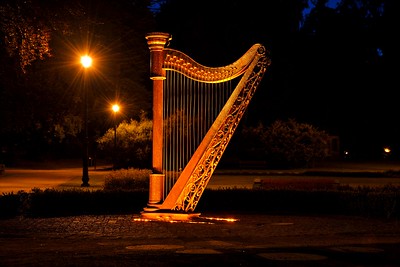
In some Mexican regions, mariachis can include the flute and even an accordion.
You can get more interesting information about mariachi in "Everything you need to know about the Mexican mariachi!". And you also can be interested in "The Mexican sombrero is an experience everybody should try!".
Is mariachi still popular?
Yes, mariachi still is really popular! This ancient Mexican tradition is absolutely alive. It’s not something you only can appreciate in a museum as it happens with other traditions. It’s in the Mexican streets, in all types of celebrations and in the world!

In 2011, the United Nations Educational, Scientific and Cultural Organization (UNESCO) registered mariachi as an intangible cultural heritage.
The Grammy Award includes a category to honor the best “Regional Mexican Music”. The award has been gotten different times by contemporary singers of “música ranchera” performed with mariachi.
We have said enough. But honestly, music is to be listened to! That’s why we have prepared for you, a short sample of mariachi songs for you to taste. Through this sample, you can also see how the mariachi has evolved to modern times and some of the variants it offers.
- Song: “Viejos Amigos”.
From the Mexican movie: “El Enamorado” (released, 1952).
In the 20th. century, radio and television were important for this music to be appreciated all around Mexico. But cinema was key for mariachi to become popular, nationally and internationally.
- Song: “Coplas”.
From the Mexican movie: “Dos tipos de cuidado” (released, 1953).
This is still a very popular “ranchera” movie. The protagonists, Pedro Infante and Jorge Negrete were considered two of the biggest stars (singers and actors) of the period called the “Golden Age of Mexican cinema”.
- Song: “El Son de la Negra” (released 1998).
Performed by Mariachi Vargas de Tecalitlán.
This mariachi was founded by members of the Vargas family, on September 15, 1898. In 1937 they began recording their first albums. Now, new generations of the family keep this mariachi’s reputation. It’s considered one of the best Mexican mariachis.
- Song: “La Bikina” (released 2000).
Performed by Luis Miguel, a Mexican singer (born in Puerto Rico) who has sung in different genres, including mariachi. He’s considered one of the best-selling singers Mexico has had.
- Song: Pumped up Kicks (mariachi version, 2012).
Performed by Foster the People and mariachi “Real de Guanajuato”.
Vive Latino is an annual music festival held in Mexico City. During its 2012 edition, “Foster the People”, an American indie pop band formed in Los Angeles, California, surprised the Mexican audience with a mariachi version of the popular song “Pumped up Kicks”.
- Saint Motel.
This American indie pop band from Los Angeles has released mariachi versions of many of its most popular songs. They seemed to start this idea in 2017 with titles like “Ace In The Hole” and “My Type”. Through time, the band has repeated the formula due to its success. In these versions (instrumental), the mariachi is the absolute protagonist.
- “Preach” (released 2020).
Performed by mariachi “Los Toros”.
- “It’s all Happening” (released 2021).
Performed by mariachi “Los Toros”.
- Song: “My Type” (released 2017).
- Song: “Ace In The Hole” (released 2017).
- Song: “Te Olvidé” (released 2020).
Performed by Alejandro Fernández, a Mexican singer who has sold over 20 million records around the world.
Is it worth to listen mariachi?
To listen to a mariachi is one of the things everybody will recommend if you visit Mexico. And we can say that it’s totally worth a try! You can listen to this music in its most traditional version or mixed with contemporary rhythms. Of course, you can like it or not. But we can say, it won’t be a boring experience. When a mariachi starts playing, people around sing, dance, and have fun!
We had very cool experiences in different Mexican restaurants that have mariachi as an amenity, and in the Plaza Garibaldi too. This last is known as Mexico City’s home of mariachi music. Honoring those great memories, today's toast is, long live the amazing Mexican mariachi!
You can get more interesting information about mariachi in "Everything you need to know about the Mexican mariachi!". And you also can be interested in "The Mexican sombrero is an experience everybody should try!".
Join PackandGo.info !
| Follow PackAndGo.info at: | |
| YouTube | @packandgo. |
| @packandgo.info | |
| X | @packandgoinfo |
| Bluesky | @packandgo.bsky.social |
| @packandgo.info | |
| TikTok | @packandgo.info |
